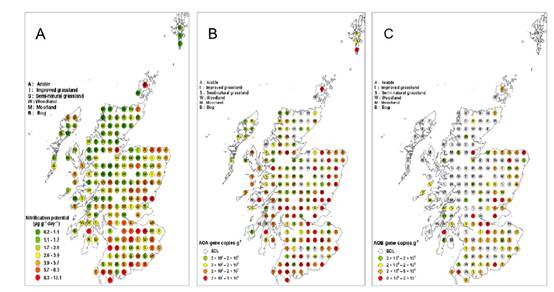The factors driving the abundance and community composition of soil microbial communities provide fundamental knowledge on the maintenance of biodiversity and the ecosystem services they underpin.Several studies have suggested that microbial communities are spatially organized, including functional groups and much of the observed variation is explained by geographical location or soil pH. Soil ammonia-oxidizing archaea (AOA) and bacteria (AOB) are excellent models for such study due to their functional, agronomic and environmental importance and their relative ease of characterization. To identify the dominant drivers of different ammonia oxidizers, we used samples (n = 713) from the National Soil Inventory of Scotland (NSIS). Our results indicate that 40–45% of the variance in community compositions can be explained by 71 environmental variables. Soil pH and substrate, which have been regarded as the two main drivers, only explained 13–16% of the total variance. We provide strong evidence of multifactorial
drivers (land use, soil type, climate and N deposition) of ammonia-oxidizing communities, all of
which play a significant role in the creation of specific niches that are occupied by unique phylotypes. For example, one AOA phylotype was strongly linked to woodland/semi-natural grassland, rainfall and N deposition. Some soil typologies, namely regosols,have a novel AOA community composition indicating typology as one of the factors which defines this ecological niche. AOA abundance was high and strongly linked the rate of potential nitrification in the highly acidic soils supporting the argument that AOA are main ammonia oxidizers in acidic soils. However,for AOB, soil pH and substrate (ammonia) were the main drivers for abundance and community composition.These results highlight the importance of multiple drivers of microbial niche formation and their impact on microbial biogeography that have significant consequences for ecosystem functioning.

Biplot of canonical correspondence analysis with environmental variables and AOA TRFs

National maps of soil nitrification potential, ammonia oxidizer archaea (AOA) and bacteria (AOB).